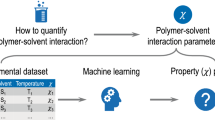Abstract
The phase transition of thermoresponsive poly(N-isopropylacrylamide) is studied under the influence of additives considered as model substances for drugs. A series of aromatic compounds with similar structures, mainly benzaldehydes, is chosen. The lower critical solution temperature (LCST) is determined by differential scanning calorimetry and 1H-NMR. All additives cause a down shift of the LCST, which depends on additive molecular structure and concentration. Since the LCST shifts are not correlated to hydrophobicity or solubility of the additive, the detailed substitution pattern is discussed as the controlling factor. The question whether LCST shifts can be explained by either the additives affecting the solvent quality or by specific interactions of additives with the polymer is addressed by LCST determination in dependence on polymer concentration. Though both factors are relevant, specific additive-polymer interactions are shown to play a major role in controlling the LCST.








Similar content being viewed by others
References
Schild HG (1992) Poly (N-Isopropylacrylamide)—experiment, theory, and application. Prog Polym Sci 17:163–249
Kuckling D (2009) Responsive hydrogel layers-from synthesis to applications. Colloid Polym Sci 287:881–891
Sukhishvili SA (2005) Responsive polymer films and capsules via layer-by-layer assembly. Curr Opin Colloid Interface Sci 10:37–44
Glinel K, Dejugnat C, Prevot M, Schöler B, Schönhoff M, Klitzing RV (2007) Responsive polyelectrolyte multilayers. Colloids Surf, A Physicochem Eng Asp 303:3–13
Rusu M, Kuckling D, Möhwald H, Schönhoff M (2006) Adsorption of novel thermosensitive graftcopolymers: Core-shell particles prepared by polyelectrolyte multilayer self-assembly. J Colloid Interf Sci 298:124–131
Ballauff M, Lu Y (2007) "Smart" nanoparticles: Preparation, characterization, and application. Polym Bull 48:1815–1823
Liu RX, Fraylich M, Saunders BR (2009) Thermoresponsive copolymers: from fundamental studies to applications. Colloid Polym Sci 287:627–643
Zhang JX, Qiu LY, Jin Y, Zhu KJ (2006) Thermally responsive polymeric micelles self-assembled by amphiphilic polyphosphazene with poly(N-isopropylacrylamide) and ethyl glycinate as side groups: Poylmer synthesis, characterization and in vitro drug release study. J Biomed Mater Res Part A 76:773–780
Wang Q, Zhao Y, Yang Y, Xu H, Yang X (2007) Thermosensitive phase behavior and drug release of in situ gelable poly(N-isopropylacrylamide-co-acrylamide) microgels. Colloid Polym Sci 285:515–521
Lynch I, Dawson KA (2004) Release of model compounds from "Plum-Pudding"-type gels composed of microgel particles randomly dispersed in a gel matrix. J Phys Chem B 108:10893–10898
Dhara D, Chatterji PR (2000) Phase transition in linear and cross-linked poly(N-isopropylacrylamide) in water: effect of various types of additives. J M S Rev Macromol Chem Phys 40:51–68
Kosik K, Wilk E, Geissler E, László K (2007) Distribution of phenols in thermoresponsive hydrogels. Macromolecules 40:2141–2147
Coughlan DC, Quilty FP, Corrigan OI (2004) Effect on drug physicochemical properties on swelling/deswelling kinetics and pulsatile drug release from thermoresponsive poly(Nisopropylacrylamide) hydrogels. J Control Release 98:97–114
Coughlan DC, Corrigan OI (2006) Drug-polymer interactions and their effect on thermoresponsive poly(N-isopropylacrylamide) drug delivery systems. Int J Pharm 313:163–174
Schild HG, Tirrell DA (1990) Microcalorimetric detection of lower critical solution temperatures in aqueous polymer solutions. J Phys Chem 94:4352–4356
Winnik FM, Ringsdorf H, Venzmer J (1990) Methanol- water as a co-nonsolvent system for poly(Nisopropylacrylamide). Macromolecules 23:2415–2416
Eliassaf J (1978) Aqueous solutions of poly(N-isopropylacrylamide). J Appl Polym Sci 22:973–874
Schild HG, Tirrell DA (1991) Interaction of poly(N-isopropylacrylymide) with sodium n-alkyl sulfates in aqueous solution. Langmuir 7:665–671
Dhara D, Chatterji PR (1999) Effect of hydrotropes on the volume phase transition in poly(Nisopropylacrylamide) hydrogel. Langmuir 15:930–935
Liu HY, Zhu XX (1999) Lower critical solution temperatures of N-substituted acrylamide copolymers in aqueous solutions. Polymer 40:6985–6990
Durme KV, Rahier H, Mele BV (2005) Influence of additives on the thermoresponsive behavior of polymers in aqueous solution. Macromolecules 38:10155–10163
Schönhoff M, Larsson A, Welzel PB, Kuckling D (2002) Thermoreversible polymers adsorbed to colloidal silica: a H-1 NMR and DSC study of the phase transition in confined geometry. J Phys Chem B 106:7800–7808
Larsson A, Kuckling D, Schönhoff M (2001) 1H NMR of thermoreversible polymers in solution and at interfaces: the influence of charged groups on the phase transition. Coll Surf A 190:185–192
Hanyková L, Labuta J, Spěvaček J (2006) NMR study of temperature-induced phase separation and polymer–solvent interactions in poly(vinyl methyl ether)/D2O/ethanol solutions. Polymer 47:6107–6116
Andersson M, Maunu SL (2006) Volume phase transition and structure of poly(N-isopropylacrylamide) microgels studied with 1H-NMR spectroscopy in D2O. Colloid Polym Sci 285:293–303
Spěváček J (2005) Phase separation in aqueous polymer solutions as studied by NMR methods. Macromol Symp 222:1–13
Rusu M, Wohlrab S, Kuckling D, Möhwald H, Schönhoff M (2006) Coil-to-globule transition of PNIPAM graft copolymers with charged side chains: a H-1 and H-2 NMR and spin relaxation study. Macromolecules 39:7358–7363
Spevacek J (2009) NMR investigations of phase transition in aqueous polymer solutions and gels. Curr Opin Colloid Interface Sci 14:184–191
Yushmanov PV, Furó I, Iliopoulos I (2006) Kinetics of Demixing and Remixing Transitions in Aqueous Solutions of Poly(N-isopropylacrylamide): A Temperature-Jump 1H NMR Study. Macromolecular Chem Phys 2006:1972–1979
Zeng F, Tong Z, Feng HQ (1997) Nmr investigation of phase separation in poly(N-isopropyl acrylamide)/water solutions. Polymer 38:5539–5544
Tokuhiro T, Amiya T, Mamada A, Tanaka T (1991) NMR study of poly(N-isopropylacrylymide) gels near phase transition. Macromolecules 24:2936–2943
Otake K, Inomata H, Konno M, Saito S (1990) Thermal analysis of the volume phase transition with nisopropylacrylamide gels. Macromolecules 23:283–289
Wang X, Qiu X, Wu C (1998) Comparison of the coil-to-globule and the globule-to-coil transitions of a single poly(N-isopropylacrylamide) homopolymer chain in water. Macromolecules 31:2972–2976
Winnik FM (1990) Fluorescence studies of aqueous solutions of poly(N-isopropylacrylamide) below and above their LCST. Macromolecules 23:233–242
Author information
Authors and Affiliations
Corresponding author
Electronic supplementary material
Below is the link to the electronic supplementary material.
Figure A
NMR spectra of 1 wt% PNiPAm in D2O at three different temperatures: 24°C (black), 33°C (red), and 40°C (blue). The assignment of the peaks is given by the numbers in the insert (PDF 27 kb)
Rights and permissions
About this article
Cite this article
Hofmann, C., Schönhoff, M. Do additives shift the LCST of poly (N-isopropylacrylamide) by solvent quality changes or by direct interactions?. Colloid Polym Sci 287, 1369–1376 (2009). https://doi.org/10.1007/s00396-009-2103-3
Received:
Revised:
Accepted:
Published:
Issue Date:
DOI: https://doi.org/10.1007/s00396-009-2103-3




